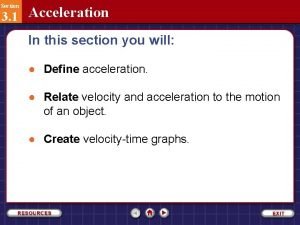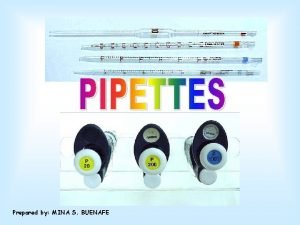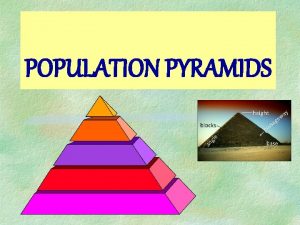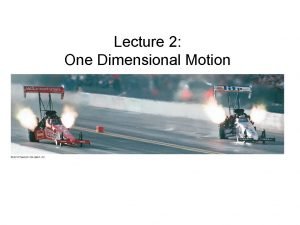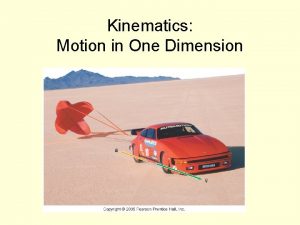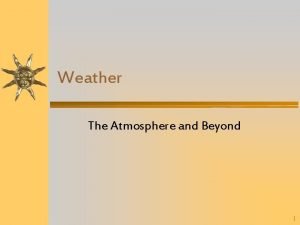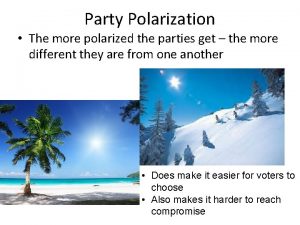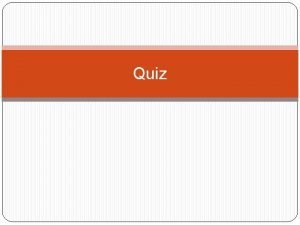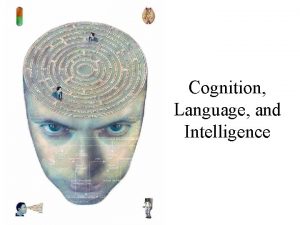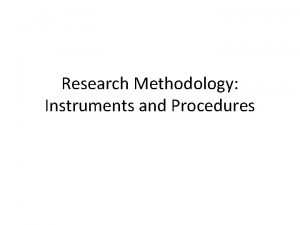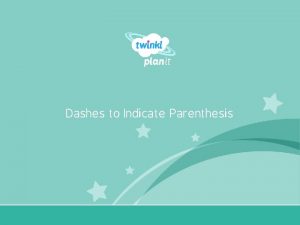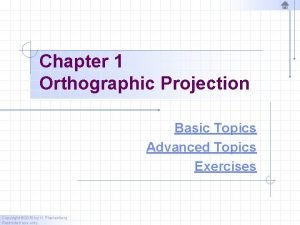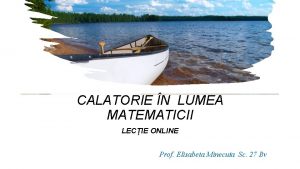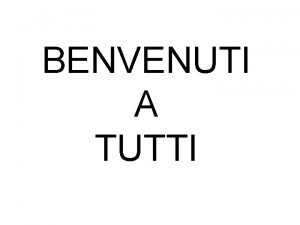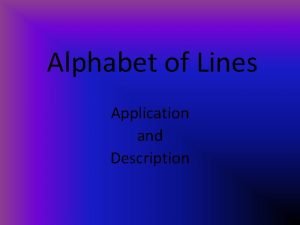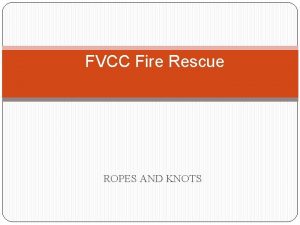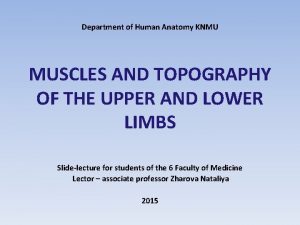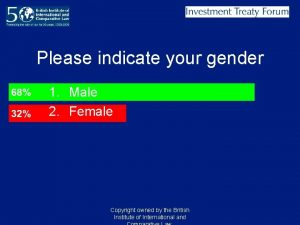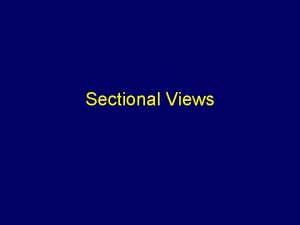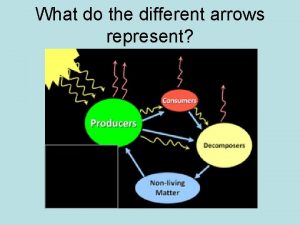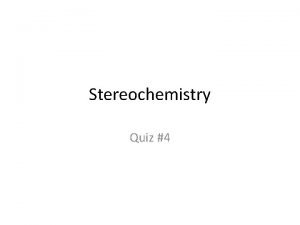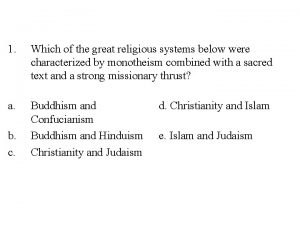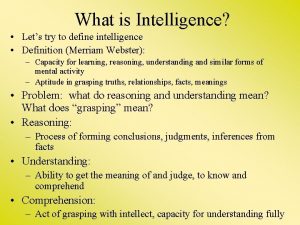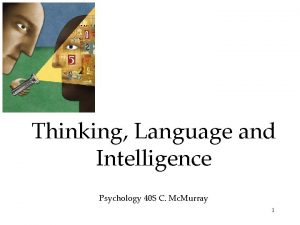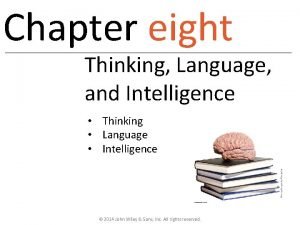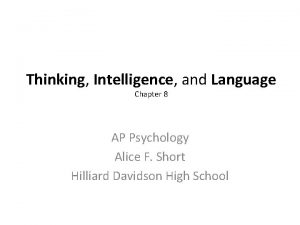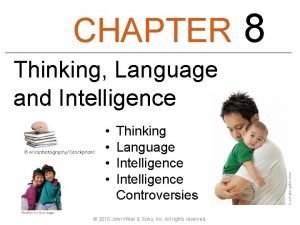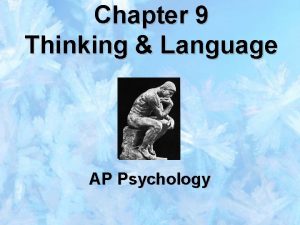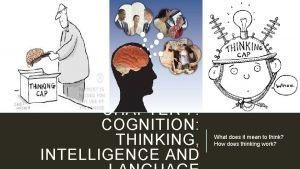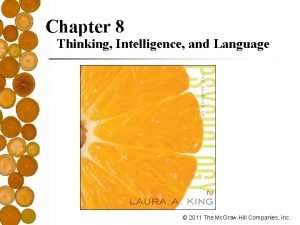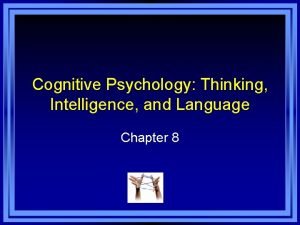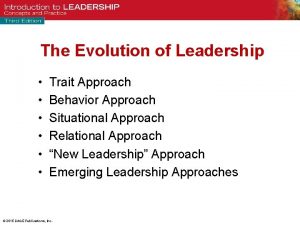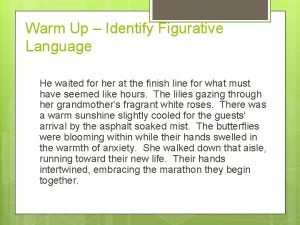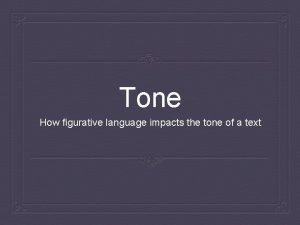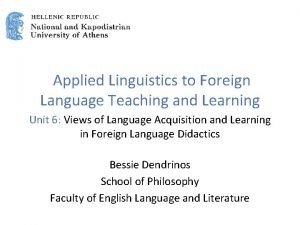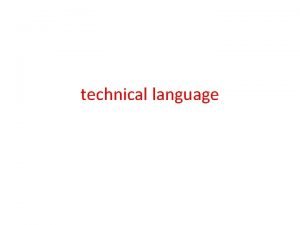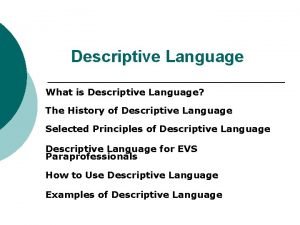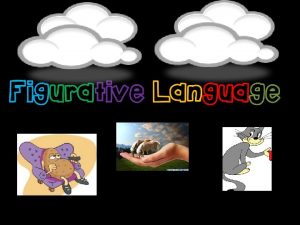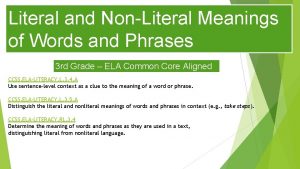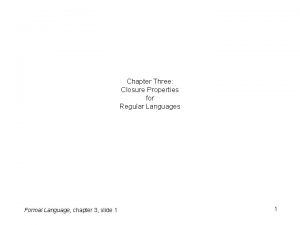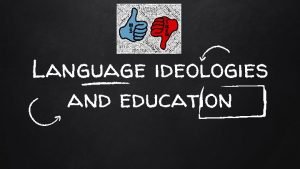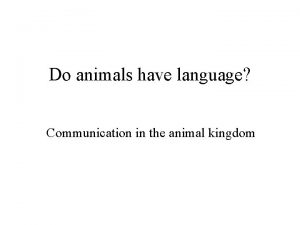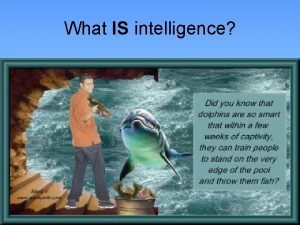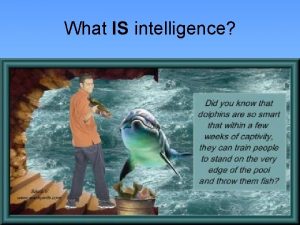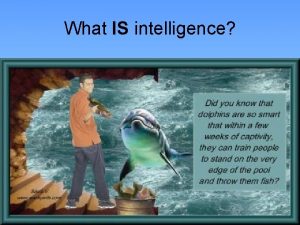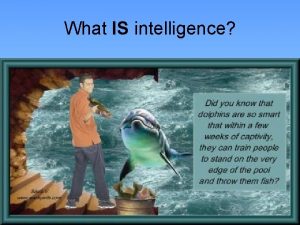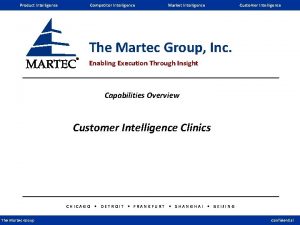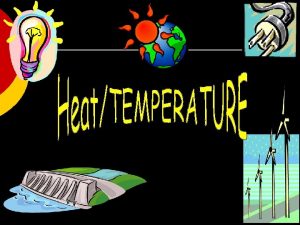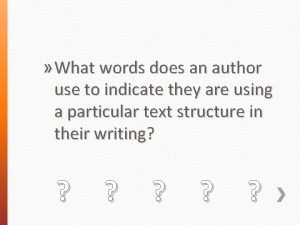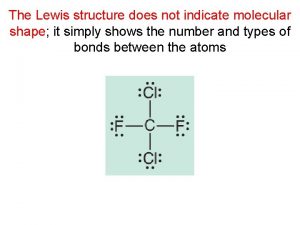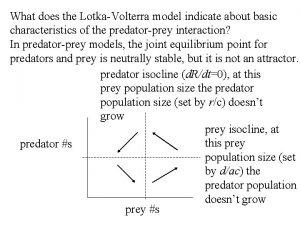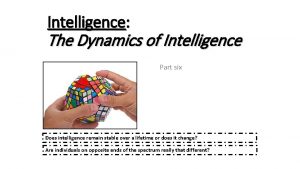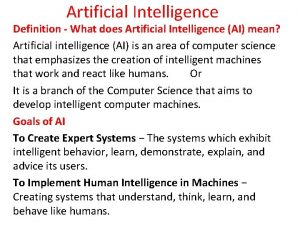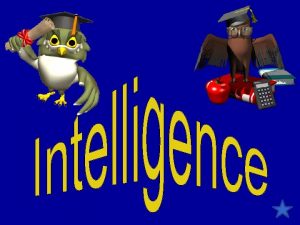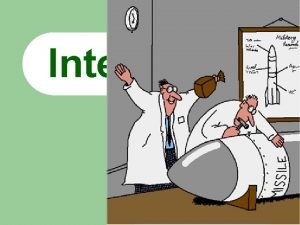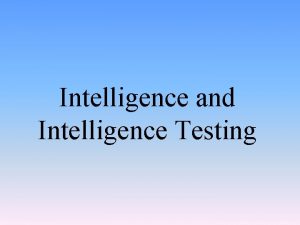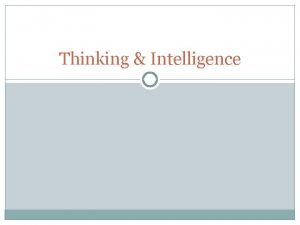What IS intelligence Does language indicate intelligence Language
































































- Slides: 64

What IS intelligence?

Does language indicate intelligence? • Language isn’t only about communication • Language allows the accumulation and transmission of knowledge and culture • thanks to language, we know things we have never personally experienced!

Language • spoken, written or signed words and the ways we combine them to communicate meaning

Do animals use language? Animals show intelligence, including communication, but is it language…? • Some researchers say “no” – Washoe “Yes” - Washoe learned was only “aping” American Sign Language copying what she had and could link words seen earlier – or together to form meaning: perhaps repeating “Water” “Bird” upon seeing behaviors that earned a swan her an earlier reward. (operant conditioning)

The debate continues….

Building Blocks of Language One of the strongest arguments against animal language, is that they fail to use proper syntax - rules we use to order the words in our sentences “you tickle” and “tickle you” mean two very different things but might be used interchangeably by ape-signers

More Building Blocks of Language • Phonemes – the smallest distinctive sound Phonemes unit (not letter) (/s/ /a/ /t/ = sat) …. changes in phonemes make different meanings (/f/ /a/ /t/ = fat) • Morphemes – the smallest unit of language Morphemes that carries meaning (a, me, pre-, -ed, ) -ed Unladylike – un- 'not' un – lady '(well behaved) female adult human' lady – -like 'having the characteristics of' like

How many phonemes (sounds) phonemes are in these words? Habits thing Three psychology 5 3 3 8

How many morphemes in the following words? People Redevelopment Swimming Language Grandmother 1 3 2 1 2

How do we learn these building blocks? • Nature vs Nurture • Remember Skinner? • Its Nurture – we are learn language through experience. Children imitate sounds that get rewarded and are thus repeated.

How do we learn these building blocks? • Nature vs Nurture • Remember Chomsky? • Its Nature – we are born with a “language acquisition device” – we absorb new words an astounding pace and we are pre-wired to utilize grammatical building blocks (such as syntax)

Critical Period • The window for learning language is wide open in our early years (our grammar “switches” are flipped on) but after the age of 7, that window gradually closes • Conclusion – language is a result of biology and experience combined

Intelligence.

1918 Army Intelligence Test l Write your answers down to the following. l No instructions will be given (that’s part of the test) l Absolutely no talking (don’t worry, its pretty short) You get 9 seconds per question only…. l

What is “Intelligence”? l Intelligence – mental quality consisting of the ability to learn from experience, solve problems, and use knowledge to adapt to new situations

g After finding that schoolchildren's grades across seemingly unrelated subjects were positively correlated, Charles Spearman proposed that these correlations reflected the influence of a dominant factor, which he termed g for "general" intelligence

What is “Intelligence”? l. Is a talented artist who can’t do math “unintelligent”? l Is a brilliant scientist who can’t follow a road map “unintelligent”?

Different cultures deem “intelligent” as whatever attributes enable success in those cultures l Different l l Is intelligence one general ability, or several specific abilities? cultures deem “intelligent” as whatever attributes enable success in those cultures

Theory of Multiple Intelligences l Howard Gardner – – – – – Linguistic Logical-Mathematical Body-Kinesthetic Spatial Musical Interpersonal Intrapersonal Naturalist Existential

Linguistic – words and language l A person's ability to construct and comprehend language l Journalists, poets, novelists, storyteller

Logical-Mathematical – numbers and logic l ability to mentally process logical problems and equations, the type most often found on multiple choice standardized tests l Scientists, accountants, navigator, surveyor

Spatial – pictures l Our ability to comprehend shapes and images in three dimensions. l perceive and interpret that which we may or may not physically see (assemble puzzle, mold a sculpture, etc) l. Artists, cab drivers, architects, chess player

Musical – music l The ability to perform and compose music l Pianist, Composers, singers

Intrapersonal – self-awareness and reflection l allows us to tap into our being - who we are, what feelings we have, and why we are this way. l. Self-help and motivational speakers, philosophers, therapists

Body-Kinesthetic - physical l Each person possesses a certain control of his or her movements, balance, agility and grace. l. Athletes, dancers, craftsperson

Interpersonal – social skills l ability to interact with others, understand them, and interpret their behavior l. Politicians, clergy, salesperson, teacher

Naturalistic – experience in the natural world l People who are sensitive to changes in weather patterns, love the outdoors or are adept at distinguishing nuances between large numbers of similar objects may be expressing naturalist intelligence abilities. l Rangers, Guides, Environmentalists, Zoologist

Existential Intelligence l Individuals who exhibit the proclivity to pose (and ponder) questions about life death, and ultimate realities l. Philosophers and Thinkers - Aristotle, Confucius, Einstein, Plato, Socrates

Triarchic Theory of Multiple Intelligences l. Robert Sternberg -Analytical -Creative -Practical

Analytical – l tests, which present well-defined problems having single right answers; academic intelligence. Commonly referred to as “book smarts”.

Creative Intelligence l – the ability to effectively adapt and deal with novel situations by drawing on existing skills and knowledge.

Practical Intelligence the ability to adapt to the environment, reflecting was is commonly called “street smarts”.

Cluster Intelligence l Louis Thurstone l l There are seven different primary mental abilities. The scores for each of the seven tests of intelligence is read separately in order to get a better understanding of strengths and weaknesses

Verbal comprehension (or Verbal Ability): l Found in such things as verbal reasoning, reasoning by analogy, reasoning and reading comprehension Somatosensory cortex is to parietal lobe as motor cortex is to FRONTAL ____

Word fluency: l Facility with words in special contexts, such as anagrams, rhyming, etc. Can you make another word from this word? ? admirer married

Number ability: l Arithmetic computation

Spatial ability: l The ability to mentally manipulate and visualize geometric relations; spatial and visual relations imagery. A

Associative memory: l The ability to make random paired associations that require rote memory; memorizing skills

Perceptual speed: l Facility in finding or in recognizing particular items in a perceptual field. l How good is your “insight”?

General reasoning ability (or Induction): l Facility in finding rules or principles, such as in a principles number series. l 3, 6, 9, 18, _____ 36

Emotional Intelligence l Salovey and Mayer l Gardner’s Multiple Intelligences PLUS: – Emotional Intelligence – superb social skills, manages conflicts well, and has great empathy for others

Creative Intelligence – Aha! l Andrew Wiles: – – Creativity is the ability to produce ideas that are both novel and valuable There are five components of a creatively intelligent person: l. Expertise l. Imaginative Thinking Skills l. A Venturesome Personality l. Intrinsic Motivation l. A Creative Environment

Intelligence and the Brain l Correlational studies have suggested that brain size and intelligence are positively correlated l Brain analyses have suggested that more intelligent people have more neural connections

Assessing Intelligence l How is intelligence determined? Testing

Two Types of Intelligence Tests l Aptitude Test – a test designed to predict a person’s future predict performance; aptitude is the capacity to learn l Achievement Test – a test Achievement designed to assess what a person assess has already learned

One Example of an Achievement Test is an IQ Test l Intelligence Test – a written method for assessing an individual’s mental aptitudes and comparing them with those aptitudes of others, using numerical scores – Student A got a 1300 SAT score, while Student B got a 900 SAT score. Student A is “more intelligent”.

Alfred Binet • The 1 st widely utilized intelligence Test l 1904 l Developed a test to identify French school children in need of alternative education

The Stanford-Binet IQ Test l 1916 Louis Terman, Stanford University l Felt that IQ was inherited and that tests would be a great way to classify children l Adjusted the test for English speaking students and utilized a colleague’s formula to derive a person’s “IQ” or “Intelligence Quotient”

How do you determine IQ? Step 1 l Mental Age – a measure of intelligence test performance devised by Binet; the chronological age that most typically corresponds to a given level of performance. – A child who does as well as the average 8 -year-old is said to have a mental age of 8.

How do you determine IQ? Step 2 l Intelligence Quotient (IQ) – defined originally as the ratio of mental age (ma) to the chronological age (ca), multiplied by 100. (MA / CA) X 100

An 8 -year old student that takes an IQ Test scores as well the average 10 -year old. – What is his IQ? – 125 10/8 = 1. 25 X 100 = 125 IQ

Its Easy! l A 6 -year old girl scored as well as a 5 year old on her IQ test, what is IQ score? 83 Mental age divided by chronological age times 100

IQ Scale l l l l Over 140 - Genius or near genius 120 - 140 - Very superior intelligence 110 - 119 - Superior intelligence 90 - 109 - Normal or average intelligence 80 - 89 - Dullness 70 - 79 - Borderline deficiency Under 70 - Definite feeble-mindedness

l Normal Curve – the symmetrical bell-shaped curve that describes the distribution of many physical and psychological attributes. Most scores fall near the average, and fewer scores lie near the extremes About. 01% score below 55 or higher than 145.

Mental Retardation l – a condition of limited mental ability, indicated by an intelligence score below 70 and difficultly in adapting to the demands of life

Intelligence Anomalies l Savant Syndrome –a person otherwise limited in mental ability has an exceptional specific skill, such as in computation or drawing; some people are functionally retarded in almost every aspect except for one very specific ability.

IQ Tests - RECAP l Stanford-Binet – the first widely used first written intelligence test l Wechsler Adult Intelligence Scale (WAIS)– today’s most widely used intelligence test; contains verbal and performance (nonverbal) subtests

What kinds of things may affect IQ? l l l Gender? Race? Wealth? Genetics/Heritability? Health Issues?

Genetic Influences l The intelligence scores of identical twins, raised together, are as similar as the scores of a single person taking the test twice l Twins raised separately have scores that are roughly 70% similar

Genetic Influences l A gene on chromosome #6 has been identified as potentially being the “IQ” gene. It has been found in 1/3 of children with very high intelligence scores. l By inserting an extra gene related to memory into fertilized mouse eggs, researchers have produced smarter mice

Environmental Influences l J. Mc. Vicker Hunt’s studies concluded that severe disadvantages, such as malnutrition, sensory deprivation, and social isolation reduce intellectual abilities l Head-Start type programs may help children prepare better for school, but not necessarily increase intelligence

Ethnic Similarities and Differences l IQ scores show much greater difference within racial groups than between them… l High scoring people and groups are more likely to attain high levels of education and income.

Gender Similarities and Differences l Girls are: – – – – More verbally fluent Better spellers More sensitive to touch, taste, and odor More capable of remembering words and the locations of objects Higher scoring in math computation tests Better at detecting emotions Higher scoring on tests of recognition

Gender Similarities and Differences l Boys: – Outnumber girls in special education classes – Talk later – Read later – Score higher on math problem solving tests – Score higher on tests of spatial ability – Score higher on tests related to the sciences – Are less emotionally sensitive
 Which rock is this
Which rock is this What does a negative acceleration indicate
What does a negative acceleration indicate Micropipette parts
Micropipette parts Broad based pyramid
Broad based pyramid The pyramid at chichen itza is most closely associate with
The pyramid at chichen itza is most closely associate with What does a negative acceleration indicate
What does a negative acceleration indicate What does a negative acceleration indicate
What does a negative acceleration indicate What does a negative acceleration indicate
What does a negative acceleration indicate Why does low air pressure usually indicate stormy weather
Why does low air pressure usually indicate stormy weather What does the graph indicate?
What does the graph indicate? In the given below statement what does the pf indicate
In the given below statement what does the pf indicate Does language reflect intelligence
Does language reflect intelligence What two things do tree rings indicate
What two things do tree rings indicate An almond or lens-shaped cloud which appears stationary
An almond or lens-shaped cloud which appears stationary It is part where you indicate the research instrument
It is part where you indicate the research instrument What is the meaning of “cpa” in manuevering board?
What is the meaning of “cpa” in manuevering board? Centrifuged
Centrifuged What do the roman numerals in a cation's name indicate
What do the roman numerals in a cation's name indicate Dashes vs parentheses
Dashes vs parentheses Auxiliary view drawing exercises
Auxiliary view drawing exercises Transformă în unitățile de măsură indicate 3 km
Transformă în unitățile de măsură indicate 3 km Espressioni logiche
Espressioni logiche Visible object line
Visible object line Displacement is scalar or vector
Displacement is scalar or vector When inspecting kernmantle rope, look at the sheath:
When inspecting kernmantle rope, look at the sheath: Muscles of the upper arm
Muscles of the upper arm Frequent earthquakes in an area may indicate *
Frequent earthquakes in an area may indicate * Indicate your gender
Indicate your gender Displacement must always indicate
Displacement must always indicate What do significant figures indicate
What do significant figures indicate What do the arrows on a cutting plane line indicate
What do the arrows on a cutting plane line indicate Indicate opposite
Indicate opposite Gusty waves indicate
Gusty waves indicate Ecosystem nonexamples
Ecosystem nonexamples Indicate the relationship of the pair of molecules shown.
Indicate the relationship of the pair of molecules shown. The type of wall decoration illustrated above
The type of wall decoration illustrated above Definitions of intelligence
Definitions of intelligence Language intelligence
Language intelligence 1. the ability to produce valued outcomes in a novel way
1. the ability to produce valued outcomes in a novel way Chapter 7 cognition thinking intelligence and language
Chapter 7 cognition thinking intelligence and language Ap psych chapter 8
Ap psych chapter 8 Thinking, language and intelligence psychology summary
Thinking, language and intelligence psychology summary Benjamin lee whorf ap psychology
Benjamin lee whorf ap psychology Chapter 7 quiz cognition thinking intelligence and language
Chapter 7 quiz cognition thinking intelligence and language Thinking affects our language which then affects our
Thinking affects our language which then affects our Chapter 8 thinking language and intelligence
Chapter 8 thinking language and intelligence Thinking intelligence and language
Thinking intelligence and language Intelligence includes having good language skills
Intelligence includes having good language skills Alesha the boy does nothing
Alesha the boy does nothing What does sensory language mean
What does sensory language mean How does figurative language affect tone
How does figurative language affect tone Ishampoo figurative language
Ishampoo figurative language Synchronic vs diachronic
Synchronic vs diachronic How does bradstreet use figurative language
How does bradstreet use figurative language Krashen's 5 hypothesis
Krashen's 5 hypothesis What does technical language mean
What does technical language mean Let it go instruments used
Let it go instruments used What is descriptive language?
What is descriptive language? Mother tongue questions
Mother tongue questions Figurative language is language that:
Figurative language is language that: Examples of literal and nonliteral language
Examples of literal and nonliteral language What language does the given dfa accepts
What language does the given dfa accepts Language brazil
Language brazil Do animals have language
Do animals have language Difference between second language and foreign language
Difference between second language and foreign language

